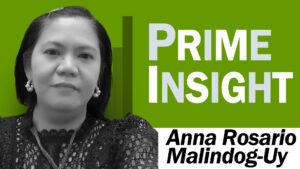THE proposed Reciprocal Access Agreement (RAA) between the Philippines and Japan marks a significant shift in defense and strategic partnerships in the Asia-Pacific region. While the agreement is touted by proponents as a step toward enhancing mutual security, bolstering defense capabilities and solidifying alliances in the face of regional uncertainties, there are several compelling reasons to consider prudence and reconsideration of such a defense/security and military agreement with Japan in the same manner that there’s a need to continue to oppose the full implementation of the Enhanced Defense Cooperation Agreement (EDCA) between the Philippines and the United States, and the installation of the four additional EDCA sites in Philippine soil from different standpoints, including national sovereignty and regional stability.
The proposed RAA will facilitate military training and operations between the Philippines and Japan. It will also create a framework for both sides to move their troops whenever required and an avenue for goods (military assets) to be imported and exported from one country to the other following the movement of visiting military forces.
RAA is akin to the Visiting Forces Agreement (VFA) between the Philippines and the US and the Status of Visiting Forces Agreement (Sovfa) between the Philippines and Australia. Japan has also RAAs with Australia and Britain. The RAA manifests the upgrading and strengthening of military and security ties between the Philippines and Japan. With the expressed strong support for RAA from House Speaker Ferdinand Martin Romualdez and with Senate President Juan Miguel Zubiri saying, “We need more than 16 votes. I believe we have more than that to ratify the RAA in the Senate,” this RAA seems a done deal even before the start of negotiations. However, once this Philippine-Japan security pact is concluded, the trilateral security-military pact between the Philippines, the US and Japan becomes highly probable and is looming on the horizon.
Now, the most relevant questions are: What are the implications of this RAA and the possibility of a triad defense pact between the Philippines, the US and Japan geopolitically speaking? How will the country’s national sovereignty and regional stability be impacted if this RAA is concluded alongside EDCA expansion?
Sovereignty and self-determination
One of the primary arguments why the Philippine government should be more prudent with the RAA is the perceived encroachment on Philippine sovereignty. The presence of foreign military installations, assets and boots on Philippine soil is a contentious topic that harks back to the era of US bases, which were expunged in the 1990s following a surge of nationalist sentiment. Allowing foreign military forces increased access to domestic bases and facilities can compromise the host nation’s control over its territory. Agreements/treaties with former colonizers and foreign powers, like RAA, EDCA, VFA and Sovfa, are manifestations of the reversal of these gains, suggesting a re-colonization of Philippine territory defense-wise and militarily speaking.
The increased presence of US military forces and assets through EDCA and VFA and now the RAA undermines the principle of sovereignty and risks placing the Philippines in a dependent position, potentially compromising its autonomy and independence in foreign policy and national defense and security matters.
On the other hand, one of the foundational concerns with a potential trilateral defense pact between the Philippines, the US and Japan is the entanglement of the Philippines in alliances that serve the strategic interests of more powerful countries like Japan and the US. In this regard, the Philippines put itself at risk in making autonomous decisions that align with its national interests. The presence of foreign military forces and infrastructure on Philippine soil through EDCA, VFA, Sovfa and now this RAA further exacerbates this issue, as it may lead to situations where a Western alliance led and prompted by the US could effectively undermine the self-determination the nation has long fought to secure since the time of Spanish, American and Japanese colonization until this very day.
Impact on regional security dynamics
On another note, the RAA and the expansion of EDCA may exacerbate tensions in the Asia-Pacific region, which is already rife with territorial disputes and power plays. Such agreements can be interpreted as provocative, potentially sparking a regional arms race or causing diplomatic strains, potentially inviting reciprocal military posturing, and signaling an escalation of the region’s US and Japan-China major rivalry and competition. For Asean, a bloc that prides itself on diplomacy, this could be detrimental to the regional equilibrium and the bloc’s centrality in managing regional security issues. With its unique position and history of territorial disputes in the SCS, the Philippines could be at the center of a geopolitical tug-of-war that may not serve its long-term strategic national interests.
Likewise, the shadow of increased military presence does not necessarily forecast a more secure future for the Philippines. The militarization of the Philippines through VFA, EDCA, Sovfa and now this RAA will only lead to a security dilemma, where one state’s defensive enhancements are perceived as a threat by others, prompting a cycle of arms buildup that could undermine peace and security in the region.
Additionally, the overt presence of US military might on Philippine soil could render the Philippines a strategic target in the event of escalated conflicts, thus jeopardizing rather than safeguarding national and regional security.
Moreover, the potential entry of a triad defense pact between the Philippines, the US and Japan into this equation could disrupt the existing state of affairs, provoking a realignment of loyalties among regional countries. Concerning Asean’s position, which has historically been one of neutrality, a trilateral pact could compromise the integrity of Asean’s unified front, creating fissures within the bloc and between Asean countries and the powers involved. Furthermore, such a pact could be seen as a provocation by regional actors not part of the agreement, chiefly China, which may view it as a containment strategy, thus potentially inflaming regional tensions.
Another critical consideration is the risk of the Philippines becoming embroiled in conflicts not of its own making. Trilateral pacts involve mutual defense commitments, which could obligate the Philippines to participate in military engagements at the behest of its allies, potentially against its own national interests. This entanglement could draw the nation into unforeseen geopolitical struggles and military confrontations, compromising its long-term peace and security. Hence, the Philippines may find itself compromised by entering into agreements that align with particular military blocs.
Conclusion
Undoubtedly, it is essential for the government under President Marcos Jr. to approach the discourse on the RAA with caution, ensuring that national interest, in its broadest and most inclusive sense, remains at the forefront.
On another note, the possibility of a trilateral defense pact between the Philippines, Japan and the US presents more than just a strategic opportunity; it is a proposition laden with risks to national sovereignty, regional stability, and the Asean’s centrality and collective security. In the face of such an alliance, the Philippines must carefully consider its position, mindful of its historic struggle for sovereignty and the potential repercussions for the Asia-Pacific region. The path toward a secure and peaceful regional environment lies not in the proliferation of military pacts but in the commitment to diplomatic engagement, mutual respect, and the unwavering pursuit of peace and harmony. In doing so, fostering a discourse that transcends immediate strategic interests and considers the long-term vision of a stable, independent, and peaceful region is essential. Only through such a comprehensive and reflective approach can the true interests of the Philippines and its neighbors be secured. As history has often shown, it is through peaceful collaboration, not through preparing for war, that nations have best secured their future.
Source: The Manila Times
https://www.manilatimes.net/2023/11/11/opinion/columns/implications-of-ph-japan-raa-enhanced-edca-and-potential-security-pact-between-ph-us-and-japan/1919174


